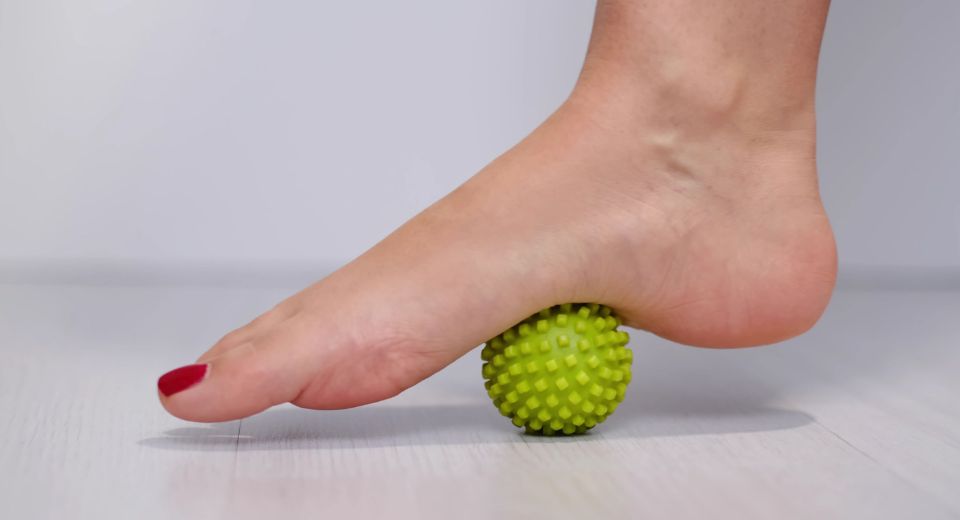
Author: Chelsea Lawrance, ATC, PA-C
Seventy-five percent of Americans will experience foot pain. The human foot contains 26 bones, 133 joints, 107 ligaments, and 19 muscles, so there are many parts to care for to prevent an injury. Stretching, proper shoes, massaging, and a healthy diet (if diabetic) are all ways to help keep your feet in good condition.
Stretching can be easily done at home using simple items such as a bath towel or golf ball. Sit on the floor with your legs straight out in front of you. Roll the towel and wrap it around your toes and pull lightly and hold for thirty seconds and repeat for three sets. Next, take the golf ball and roll it back and forth from your heels to your toes. Next, find a step and stand with your toes on the step with heels off the edge. Lower your heels down slowly and hold for ten to fifteen seconds, then lift back to the starting position. Repeat five to ten times, this works great with people living with plantar fasciitis.
Finding the Right Shoe
- Choose a shoe that conforms to the natural shape of your foot. Make sure the ball of your foot fits into the widest part of the shoe.
- Try not to wear shoes that are higher than a 2 1/4’ heel. This can cause bunions and calluses.
- When purchasing new shoes, you might want to try on both shoes, since one foot is sometimes larger than the other.
- Don’t always rely on shoe size, try on the shoes since sizes vary among brands.
- Have each foot measured regularly, feet tend to change in shape and size with age.
Massaging your feet can improve circulation and relieve pain and discomfort. Place your foot between your hands, with your fingers facing forwards. Rub your hands backwards and forwards along your foot, creating warmth. Place one thumb on top of the other, using your fingers to support your foot, and make circular thumb pressures over the sole of your foot. Stroke the area and then repeat the sequence. For toes, with one hand, stretch your toes back gently. Use your other hand with an open palm and gently tap the sole of your foot. This will stimulate blood circulation.
If you’re a diabetic, it is very important to care for your feet. The feeling in your feet can slowly dissipate when you have diabetes. If you can’t feel your feet, you take the chance of missing foreign objects making their way into the sock or shoe. You can form blisters, which can lead to open sores and cuts. Check your feet everyday when you take off your shoes. For people suffering from diabetes, a bad shoe day can be detrimental to the health of your feet . Wearing the wrong kind of shoes can lead to serious problems, and sometimes can be so serious that amputation can occur. Wearing therapeutic shoes helps to minimize the risk of skin ulcers and breakdown for diabetics.
Daily Foot Care Routine
- Wash Feet Thoroughly: Use warm water and soap. Enjoy this time and give yourself an added mini foot massage!
- Exfoliate: It is an important step that is often left out. Exfoliating feet daily has the added benefits of softer, healthier feet. While also cleaning out clogged pores and reducing the risk of calluses and/or fungal infection. Try using a pumice stone or exfoliating cloth.
- Dry Feet Thoroughly: It will ensure that all the moisture is removed from your feet. It is crucial for the next step.
- Use Lotion: There are so many lotions on the market. Whatever you fancy, you can probably find it. Bonus: Give yourself an extra minute foot rub to make sure the lotion is well absorbed.
Weekly Foot Care Routine
Once a week, treat yourself to an at-home foot soak! Epsom salt is known to detoxify and soften the skin. The acid from the lemon juice helps to remove dead skin. Plus, it smells amazing!
Ingredients for the foot soak:
- 1 Lemon (juice and peel)
- 2 tablespoons (white or apple cider) vinegar
- 3 cups of Epsom salt
Foot soak instructions:
- Add lemon juice, vinegar, and Epsom salt to a tub of warm water.
- Use the insides of the lemon to clean the feet.
- Soak feet for 10-15 minutes.
- Finish out with your daily foot care routine!
If you or a loved one are experiencing discomfort or notice any physical changes in your lower extremities, it is best to contact a podiatrist or medical provider for further support.
The information provided is for general interest only and should not be misconstrued as a diagnosis, prognosis or treatment recommendation. This information does not in any way constitute the practice of medicine, or any other health care profession. Readers are directed to consult their health care provider regarding their specific health situation. Marque Medical is not liable for any action taken by a reader based upon this information.

